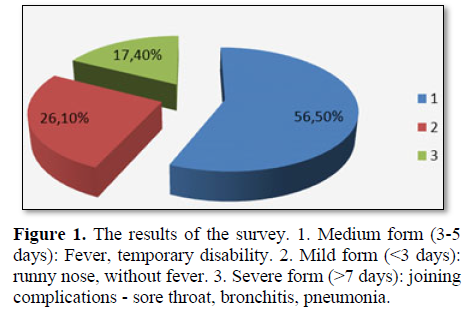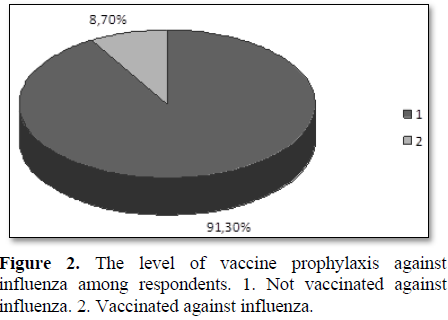Research Article
Analysis Questionnaire Population in Odessa on Acute Respiratory Viral Infections
839
Views & Citations10
Likes & Shares
To date, most of the key issues regarding the control of respiratory infections have not been resolved in scientific, methodological and practical terms. The main reasons for this are the polyethiologic and diversity of clinical forms of ARF, the presence of a large number of serological variants and strains of pathogens, their frequent changes, uneven distribution in various climatic and geographical zones, as well as serotype specificity of immunity. However, it is with these diseases that most often deals with a family doctor and a district therapist - about 70 % of all ambulatory disease is ARI. The consequences of these diseases can be very difficult complications. The purpose of the work was to develop a questionnaire, to conduct a population survey in Odessa and to generalize the data on the population's attitude to the problems of the morbidity of the influenza virus and other SARS, as well as to determine the level of their vaccination against the flu.
Research methods: 70 people from different social groups were interviewed: Students, working people, pensioners aged 17 to 76 years. The work used medical-sociological and statistical methods of research.
Results and Discussion: A questionnaire survey conducted by our population in Odessa showed that there is a constant frequency of SARS morbidity 1-2 times per season. The cases of influenza virus were mostly transmitted in average form (56.5 %) for 3-5 days, with high body temperature and disability. In 17, 4 % there was a complication of acute respiratory infections (angina, bronchitis, pneumonia). For the treatment of an already occurring disease, the respondents used mostly combined methods (72.5 %): Antipyretics and folk methods (tea, mustard, etc.).
Conclusions: The results of the study indicate a low level of trust in the organization of medical care among the population - only 20.3 % of the respondents turned to the doctor after the first symptoms appeared. The low level of vaccination was detected among the respondents (8.7 %) - the majority of the population never vaccinated with influenza - 91.3 %.
Keywords: Questionnaire, Influenza virus of the population of Odessa, Vaccination level, Complication of the diseasea
INTRODUCTION
Due to the high variability of antigenic structure, virulence of circulating viruses and the emergence of new highly pathogenic pathogens (pandemic influenza A virus (H1N1/2009), coronaviruses, avian influenza A virus (H5N1), etc.), acute respiratory viral infections (SARS) infection. The accompanying complications are also a serious danger [1-6]. In Ukraine, a number of normative documents and measures aimed at monitoring and reducing the incidence of SARS have been developed [7]. However, every year 10-14 million people get SARS, which is 25-30% of all and about 75-90% of infectious diseases in the country. The results of numerous studies show that in Ukraine the incidence of SARS (including influenza) is at a consistently high level.
The purpose of the study is to conduct a survey of the population of Odessa and to summarize data on the attitude of the population to the problems of SARS, to determine the level of vaccination against influenza.
MATERIALS AND METHODS OF RESEARCH
We developed a questionnaire containing 8 questions on the incidence of SARS, grouped into 2 groups. A survey was conducted among the population of Odessa according to the questionnaire developed by us (spring 2014). As a result, information was obtained in two areas: Frequency and duration of SARS, medical treatment, methods of treatment and prevention, the level of influenza vaccination among respondents.
70 people from different social groups were interviewed: Students, people of working age, retirees. The average age of the respondents was 35.4 ± 3.2 years, from 17 to 76 years. Among them by gender: 66.67% - women, 33.33% - men. Medical-sociological and statistical research methods were used in the work.
RESULTS AND DISCUSSION
The results of the survey of the population of Odessa showed that 74.0% suffer from SARS 1-2 times a year (season), 13.0% get sick more than 3 times a year, 11.6% never get sick. According to the survey, 40.6% of symptoms of SARS were observed a month ago, 30.4% of respondents had a recent infection (1-2 weeks ago), the rest of the respondents were ill more than 2 months ago.
Of particular interest are survey data on the duration and severity of SARS. About half of the respondents (56.5%) suffered from the disease in moderate form (3-5 days), which was accompanied by fever and disability (Figure 1).


42.0% of respondents sought medical help only in case of severe symptoms and complications, 21.7% - did not seek medical help at all in the event of these diseases. Only 20.3% of respondents always consulted a doctor at the initial symptoms of the disease. 16.0% of respondents were engaged in self-medication.
More than half of the respondents (72.5%) in the treatment of SARS use combined treatments-antipyretics and alternative medicine. Only non-traditional medicine (herbal teas, mustard seeds, etc.) was used to treat respiratory infections by 17.4% of respondents. 5.8% of respondents did not take any drugs and alternative medicine. Respondents' attitudes to influenza vaccination were also studied. It was found that 91.3% of respondents had never been vaccinated against influenza (Figure 2).
CONCLUSIONS
- There was a very low level of vaccine prophylaxis against influenza among respondents: 8.7%. The majority of the population has never been vaccinated against influenza (91.3%), which is a negative indicator for the prevention of this disease in this way.

- Our survey of the population of Odessa showed that 74.0% of the population of Odessa suffer from SARS 1-2 times a season.
- Only 20.3% of respondents always sought medical help at the first symptoms of the disease and 42.0% of respondents sought medical attention only in case of severe symptoms and complications. This may indicate a low level of trust in the organization of medical care among the population.
- The incidence of SARS respondents suffered mainly in moderate form (56.5%) for 3-5 days, with fever and disability. In 17.4% there were complications - sore throat, bronchitis, pneumonia, which may be associated with late treatment of patients.
- In the treatment of SARS, 72.5% of respondents used mainly combined methods of treatment - antipyretics and alternative medicine. Only non-traditional medicine (herbal teas, mustard seeds, etc.) was used by 17.4% of respondents to treat respiratory infections.
- Neumann G, Noda T, Kawaoka Y (2009) Emergence and pandemic potential of swine-origin H1N1 influenza virus. Nature 459: 931-939.
- Shinya K, Ebina M, Yamada S, Ono M, Kasai N, et al. (2006) Influenza virus receptors in the human airway. Nature 440: 435-436.
- Bautista E, Chotpitayasunondh T, Gao Z, Harper SA, Shaw M, et al. (2010) Clinical aspects of pandemic 2009 influenza A Н1N1 virus infection. N Engl J Med 362: 1708.
- Yang Y, Liu C, Du L, Jiang S, Shi Z, et al. (2015) Two mutations were critical for bat-to-human transmission of middle east respiratory syndrome coronavirus. J Virol 89(17): 9119-9123.
- Ilicheva TN (2012) Reproduction of human influenza virus and the disease it causes Immunopathogenesis. Infect Dis 10: 58-65.
- Pechinka AM, Dzeman MI (2010) Hostri respiratorni zakhvoryuvannya: Pytannya klinichnoyi diahnostyky ta likuvannya Acute respiratory infections the issue of clinical diagnosis and treatment. Ukrayinskyy medychnyy zhurnal - Ukrainian Med J 5(79): 94-103.
- Unifikovanyy klinichnyy protokol pervynnoyi medychnoyi dopomohy doroslym ta dityam. Hostri respiratorni infektsiyi (2014) The unified clinical protocols of primary care for adults and children. Acute respiratory infection. Curr Infectol 3(4): 113-191.



